Fish migration in the Mekong River: Identification of dam development impacts on commercially important fish species
Michio FUKUSHIMA
Senior Researcher, Ecosystem Function Research Section
Center for Environmental Biology and Ecosystem Studies
National Institute for Environmental Studies
| The National Institute for Environmental Studies (NIES), Japan, and Ubon Ratchathani University, Thailand, have elucidated the migration patterns of Siamese mud carp (Cyprinidae), a highly valued fisheries resource in the Mekong River, and quantitatively assessed the potential impacts of dam development on this species. The analysis of trace elements deposited in the otolith (ear bone) of the Siamese mud carp has led to the following three major research findings: 1) local populations of Siamese mud carp have specific migration routes along which they migrate in schools, 2) their migration range has already been severely impacted in a tributary fragmented by existing dams, and 3) the planned Don Sahong Dam in southern Laos will most likely obstruct an important migration route of the species, potentially leading to a significant loss in the fisheries production of the Mekong River. This study was published in PLOS ONE on August 6, 2014. (URL:http://dx.plos.org/10.1371/journal.pone.0103722) |
1. Introduction
The Mekong River, an international river flowing through six countries in Southeast Asia, has not to date been subject to obstruction by dams, with the exception of its farthest upstream reaches in Chinese territory, and the lower course of the river remains almost entirely unobstructed as far as the Mekong Delta in Vietnam. The river has the world’s largest inland fisheries production (2.6 million tonnes per year) and contains the second highest number of fish species (approximately 1200 species) after the Amazon River. The extremely high aquatic production and biodiversity are, to a large extent, due to fish species with life cycles of a migratory nature. However, as a result of increased electricity demand in the region, the Mekong River is currently faced with the prospect of several dozen dam development plans. As a consequence of such development, impacts on the abundance and distribution ranges of migratory fish species can be considered inevitable. Reconciling increased electricity supply as provided by the proposed dams, with ecological services such as food security, livelihood, and local culture, all of which are threatened by the same dams, is the immediate priority for riparian countries of the Mekong, as well as development partners such as Japan. One potential key to the resolution of this issue is a quantitative scientific assessment of the particular ecological services at risk.
The two Siamese mud carp species (Henicorhynchus siamensis and H. lobatus) we studied are cyprinids with a typical length of about 15 cm (Photo 1). Despite their relatively small body sizes, they constitute an extremely important fisheries resource, producing the largest yield when the two species are combined among all fishes harvested in the Mekong River (>12% of total catch). Although it has long been known from accounts of local fishermen that these species are migratory, scientific evidence and understanding of the exact nature of their migration behaviors and routes has yet to be provided.
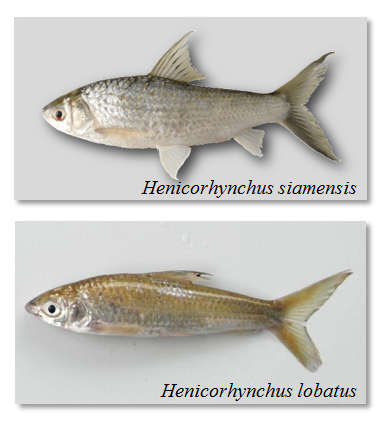
This study investigated the movement of the Siamese mud carp using a novel technique to analyze trace elements incorporated into the otolith (ear bone) of a fish from ambient water of various tributaries and regions through which it is possible the fish migrated. The study also assessed the effects of existing dams on a tributary of the Mekong. Furthermore, it projected the potential impacts on the species of the proposed Don Sahong Dam in the Mekong River’s mainstream in southern Laos.
2. Methods
We collected 200 Siamese mud carp individuals from a total of 29 sampling sites throughout the Mekong River Basin including northern Thailand, the Songkhram River, the Gam River, the Mun River, Tonle Sap Lake, and the Mekong River’s mainstream (Fig. 1). We brought samples of both otoliths and river water from each site to a laboratory to determine potential marker elements and to reconstruct the migration pattern of individual fish. With regards to the otolith samples, we assayed elements both from the otolith surface and its interior, from core to edge (Photo 2) using an inductively coupled plasma mass spectrometer equipped with a laser ablation system. We quantified the concentrations of the following elements: sodium (Na), magnesium (Mg), calcium (Ca), manganese (Mn), copper (Cu), zinc (Zn), strontium (Sr), and barium (Ba). The data were standardized to Ca concentration to correct for the variability in laser energy and weight of ablated material.
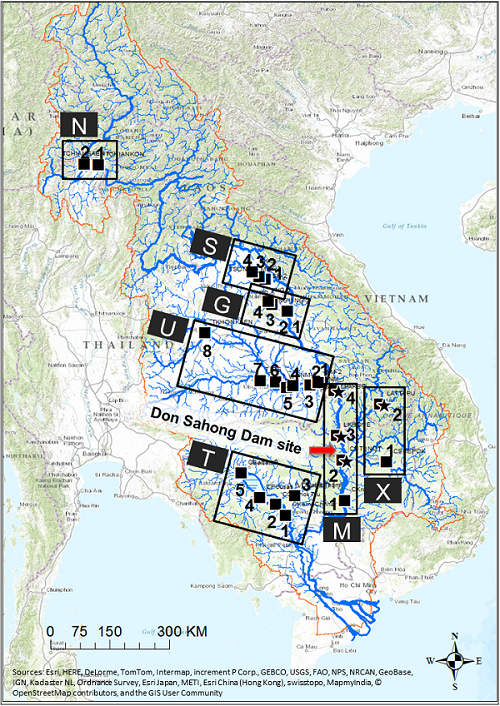
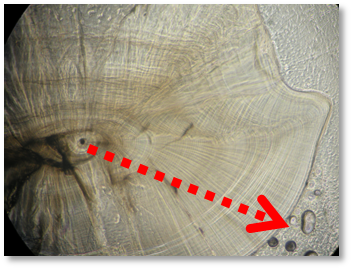
3. Results
3-1. Marker elements
Among the elements assayed, Na, Zn, Sr and Ba had significant positive correlations between otolith surfaces and river water of fish sampling sites. In other words, these elements were incorporated into otoliths in proportion to their ambient abundance. The otolith-water correlations were particularly strong for Sr and Ba, indicating that they can be considered reliable markers for the reconstruction of migration routes. Meanwhile the concentrations in water of Sr and Ba varied greatly among different regions but annual values were relatively constant within regions, indicating that the water elemental signatures are not uniform throughout the basin but rather unique to different regions. Therefore, we can conclude that the basic requirements for the otolith microchemistry technique to elucidate fish migrations have been met.
3-2. Migration of H. siamensis
The profiles of Sr and Ba deposited along the core-to-edge axis of the Siamese mud carp (H. siamensis) otolith were fairly similar among individuals within regions but different across regions, suggesting that 1) the individuals collected in a given region were born in the same habitat and migrated together in a school, but that 2) their migration routes and ranges differed among the regions (Fig. 2). In particular, despite relatively large body size (> 130mm), fish in the Gam River showed the Sr-Ba signatures with only minor variations being confined in a space with low Sr and Ba levels in the biplot. In addition, these profiles showed only minimal overlap with those in other regions. The Gam River is impeded by a total of five irrigation dams, which most likely explains the limited variability and unique shape of the elemental profiles for this tributary (Fig. 1). The Siamese mud carp migrations must thus have been severely impeded by the dams, and the fish presumably have never emigrated to the Mekong River’s mainstream or other tributaries.
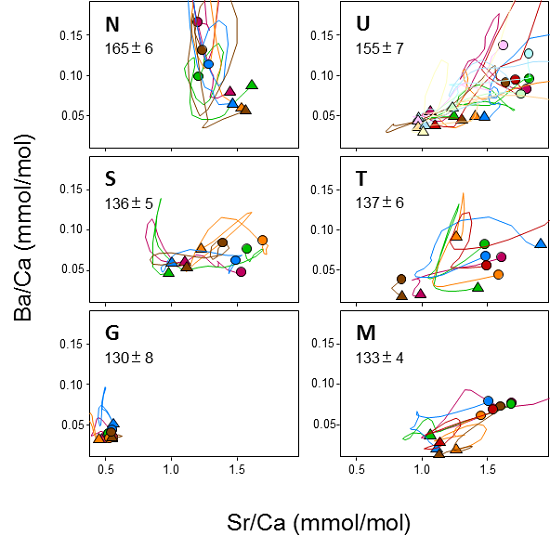
3-3. Migration of H. lobatus
Another species of Siamese mud carp, H. lobatus, is an important fisheries resource harvested in large numbers around the proposed construction site of Don Sahong Dam. The species was sampled at three sites located along a 200-km stretch of the Mekong River’s mainstream in the environs of the proposed dam site (i.e., 1 site downstream and 2 sites upstream). The otolith data show that 1) Sr-Ba profiles had mutual resemblances among the sampling sites, 2) in particular, the Sr-Ba signatures at the otolith core, which are representative of the water chemistry of the birthplace, showed few variations among the sites (p>0.05), but 3) the elemental signatures at the otolith edge, which are representative of the chemistry of the capture sites, were different (p<0.05) (Fig. 3). These observations indicate that the Siamese mud carp from the three sites originated from the same habitat at birth and were later captured by fishermen as they dispersed either up- or downstream passing through the proposed dam site. According to previous studies (Hurwood et al. 2008), the genetic diversity of the species increases toward upstream, supporting the possibility of active upstream migration by the species through the dam site during their life cycle. In summary, Don Sahong Dam will undoubtedly exert a significant impact on the Siamese mud carp population. Together with possible impacts on other migratory fish species, the dam project represents a serious problem that may undermine the fisheries industry and the entire economy of the Mekong Basin.
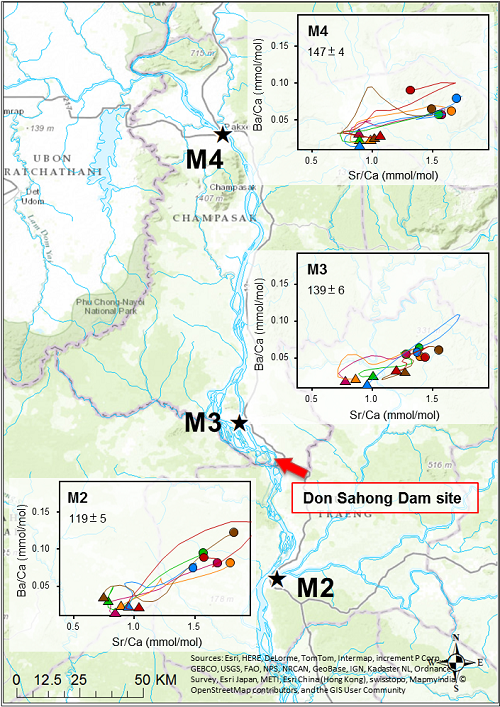
4. Perspective
Issues related to dam development in international rivers such as the Mekong River have rarely been resolved in a satisfactory manner, as the environmental and social impacts of the proposed dams have the potential to spread to neighboring countries with conflicting interests. Proporsals by dam proponents are relatively favorably received by decision-makers, but those put forward by dam opponents including local fishermen and conservationists have rarely been adopted, in particular in developing countries. This is mainly because of the extreme difficulty in satisfactorily answering questions such as: “Do dams really decrease fish abundance?” or “Will local fisheries or livelihoods be impacted by damming?” This study was to some extent successful in providing science-based answers to these questions. Possible future research options may include: 1) increasing target species for the otolith analysis, 2) improving the accuracy of elucidations of fish migrations utilizing a stable Sr isotope as a marker, 3) conducting an otolith elemental analysis in conjunction with the conventional methods of radio telemetry or tagging in order to better understand fish migrations in the Mekong River. In the meantime, an overly optimistic view of dam construction is frequently put forward by dam proponents, in which they claim that even though dams negatively influence the existing capture fisheries, a huge impoundment as created behind a dam site would represent a great opportunity to facilitate the recovery of lost fisheries resources by means of new aquaculture production. The question as to whether or not this is an accurate hypothesis will require scientific validation.
5. Contact information
Michio FUKUSHIMA
Senior Researcher, Ecosystem Function Research Section
Center for Environmental Biology and Ecosystem Studies
National Institute for Environmental Studies
Tel: +81-29-850-2427 E-mail: michio@nies.go.jp
6. Published article
Fukushima M., Jutagate T., Grudpan C., Phomikong P., Nohara S. (2014). Potential effects of hydroelectric dam development in the Mekong River Basin on the migration of Siamese mud carp (Henicorhynchus siamensis and H. lobatus) elucidated by otolith microchemistry. PLOS ONE doi:10.1371/journal.pone.0103722.
7. Collaborator
Ubon Ratchathani University (Thailand)
8. Funding sources
This study was supported by the Mitsui & Co., Ltd. Environment Fund (R08-B034) to MF and TJ, the Environment Research and Technology Development Fund (4D-1202) of the Ministry of the Environment, Japan to MF, and the Royal Golden Jubilee Ph.D. Program of the Thailand Research Fund (Ph.D./0236/2551) to PP.
- What's New
- What's New 2025
- What's New 2024
- What's New 2023
- What's New 2022
- What's New 2021
- What's New 2020
- What's New 2019
- What's New 2018
- What's New 2017
- What's New 2016
- What's New 2015
- What's New 2014
- What's New 2013
- What's New 2012
- What's New 2011
- What's New 2010
- What's New 2009
- What's New 2008
- What's New 2007
- What's New 2006
- What's New 2005
- What's New 2004
- What's New 2003
- What's New 2002
- Event Information
- Visit NIES